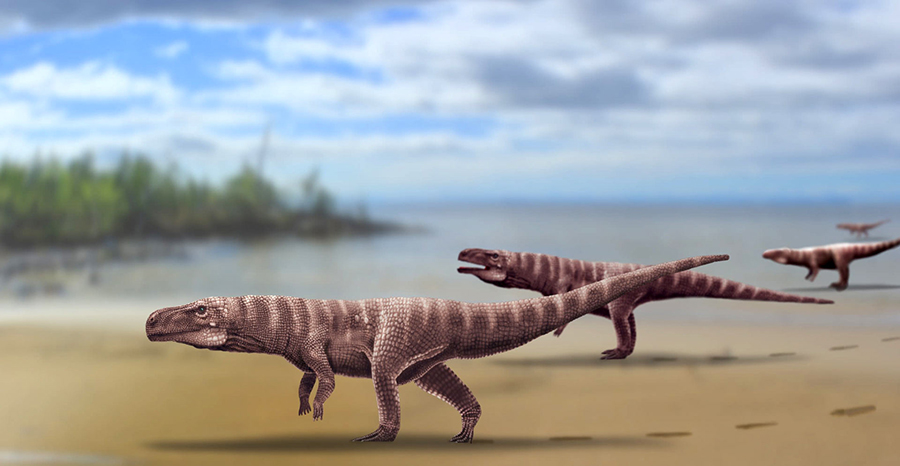Cretaceous-Period Crocodiles from Korea Walked on Two Legs

Multiple, well-preserved trackways made by large crocodylomorphs, extinct ancestors of modern-day crocodiles, between 110 and 120 million years ago (Cretaceous period) have been found near Sacheon City in South Korea. Surprisingly, the trackways never include handprints and indicate exclusively bipedal walking, a gait not known from fossil crocodylomorph trackways.
Professor Kyung Soo Kim from Chinju National University of Education and colleagues discovered the well-preserved crocodylomorph trackways with clearly defined foot impressions and localized skin traces at the Sacheon Jahye-ri site of the Jinju Formation.
The tracks are between 18 and 24 cm long, indicating trackmaker body lengths over 3 m.
“It shocked us to learn that the trackways represent bipedal animals 3-4 m long,” Professor Kim said.
“The footprints were initially thought to be made by a giant bipedal pterosaur walking on the mudflat, we now understand that these were bipedal crocodile prints,” said University of Queensland’s Dr. Anthony Romilio.
“The footprints measure around 21 cm, suggesting the track-makers had legs about the same height as human adult legs. These were long animals that we estimate were over 3 m in length.”
“And while footprints were everywhere on the site, there were no handprints.”
The paleontologists initially questioned the absence of hand impressions from the trackways, given that modern-day crocodiles are quadrupedal (four-legged).
“Fossil crocodile tracks are quite rare in Asia, so finding an abundance of nearly one hundred footprints was extraordinary,” Dr. Romilio said.
“As an animal walks, the hind feet have the potential of stepping into the impression made by the hand and over-printing it, but we find no evidence of this at these Korean sites.”
“It isn’t due to poor preservation either, because these fossils are spectacular, they even have the fine details of the toe-pads and scales on their soles preserved.”

The researchers named the new tracks Batrachopus grandis emphasizing the large size in comparison with much older and smaller 2-3-cm-long tracks of the Batrachopus type, commonly found in the Jurassic of North America.
“Nobody expected such large bipedal crocs. The Jinju Formation is so rich in tracks; you can read the entire ecology,” said University of Colorado’s Professor Martin Lockley.
Among the remains of some of the oldest terrestrially adapted crocodiles are large species that lived more than 200 million years ago (Triassic period), and some paleontologists think they may have been bipedal.
“The Korean trackways prove this hypothesis, at least for the Cretaceous period,” Dr. Romilio said.
“It also proves this adaptation was effective for millions of years, even with big fierce dinosaurs running around.”
The study was published in the journal Scientific Reports.
_____
K.S. Kim et al. 2020. Trackway evidence for large bipedal crocodylomorphs from the Cretaceous of Korea. Sci Rep 10, 8680; doi: 10.1038/s41598-020-66008-7
Source: www.sci-news.com/
